Costume: the basics, part 2
Last entry I wrote about the basics of a costume; undergarment and spare-clothing can be very important, either for you or to help others.
This week I’ll try to tell you how to get started with a costume. What are things to keep in mind? Where to start in the ocean of ideas? And of course some other basics you may not even have known about.
I have a guest-writer for this entry; thank you John both for helping me and your enthusiasm. Because of this I’ll split this entry. The first part is mine; the second part is John’s.
Happy creating! Alexjuh
Managing inspiration
In the posts ‘Creating a race, part 1 and part 2’ I told you how to get your ideas on paper; how to use a mind map, how to figure out your basics and how to cross ideas off. These tips and tricks also apply to creating a costume but instead of writing down ideas for a new race, you write down your inspiration for a costume. You can pretty much work the same way.
To summarize:
- Search for inspiration, whether this is in movies, books, the internet, friends or anything else you’re inspired by.
- Write down all these ideas; nothing is good, bad or unreachable, don’t limit yourself yet.
- Create a mind map. Ask yourself questions such as: what are your goals? What do you want to communicate with your costume? Etc.
- Take a step back for a couple of days.
- Reality check. Cross off the insane and/or unachievable ideas. Keep in mind the budget you have available, how much time you have, if you can create certain things yourself or have to buy them, the type of LARP and the time of the year. Also the history of your character can be very important for a costume.
For example: if your character has been travelling for six years and hasn’t had the time or money to buy (or steal) something new, you probably have ragged clothes, broken weapons, maybe even wounds.
After you’ve collected some great ideas, I advise you to make a sketch. It doesn’t matter if you can draw or not, as long as you understand what you want to create. A Sketch can be very important in a later stadium; when you are creating the costume, you can lose track of minor details, which can make or break the costume. It’s also clever to write down the steps in which you’re going to create the costume, maybe even write down the steps of certain costume parts. Sometimes you forget little details during the creation process and if it’s irreversible, you can have a problem.
Colour
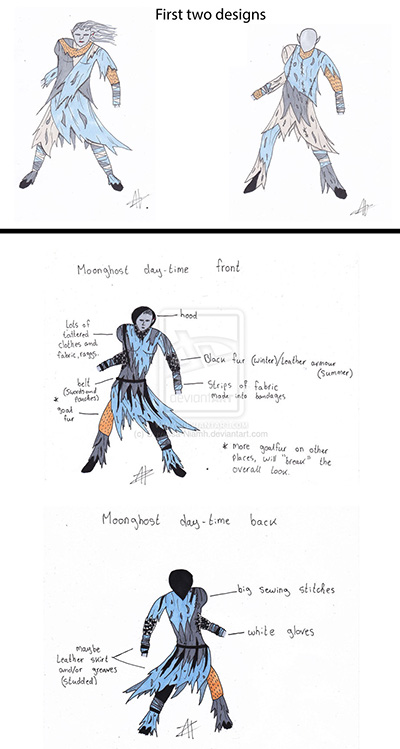
It’s often forgotten that this is one of the foundations of your costume. Colour can make or break your costume and can give you an advantage in certain conditions.
First of all I want to tell you about the colour schemes used by artists. There are three primary colours, blue, yellow and red. With these three colours you can create any other colour except for black and white, which aren’t colours actually. Every primary colour has a secondary colour as opposite. Put these colours next to each other and they make each other more intense.
For example: when you are at the butcher shop, there are those green fluffs between the meat. Well, they do that because it makes the meat look more red, which makes it look more fresh.
These are the opposites: red – green, blue – orange and yellow – purple. As you can see, green doesn’t contain red. This puts them opposite of each other and is the reason they stand out. The same applies to the other primary and secondary colours and even applies to the tertiary colours.
This illusion can be used for colours in your costume as well, making the colours stand out more, if you like. If you don’t want to be noticed, avoid using opposite colours.
Then there is the issue of certain colours clashing such as red and pink. When you use only one colour, make sure the slight variations in this colour match.
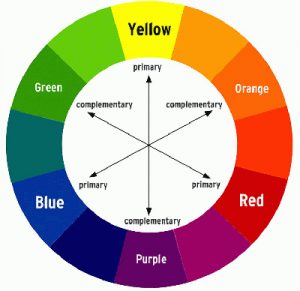 For example: when you play a Wood Elf you probably are going to use a lot of greens. Combining mint-green and dark-green can look very stupid. And when playing this Wood Elf, you probably want to be able to sneak around unnoticed in the woods. Mint-green isn’t a colour often produced by nature, so you will be seen.
For example: when you play a Wood Elf you probably are going to use a lot of greens. Combining mint-green and dark-green can look very stupid. And when playing this Wood Elf, you probably want to be able to sneak around unnoticed in the woods. Mint-green isn’t a colour often produced by nature, so you will be seen.
And last but not least: black. A popular colour because it forms an easy basic colour; any other colour goes with black which gives it a huge advantage. But there are certain disadvantages to this colour. First of all, a lot of people wear black, especially assassins, thieves and rogues. If you want to stand out, avoid this colour because with black you will just end up in the mass. Second of all, a lot of people think you won’t see black during the night. Well here is the surprise, you actually do see black during the night, especially when there is a lot of moon- or starlight. This is because the night is never entirely black; there will always be a little bit of light, whether this is from a nearby city, a light someone carries, or as I said before, moon- or starlight. Dark-blue or dark-green are harder to see; they blend into the forest and/or blend into the night. Third of all, and this is applies to low- and high fantasy-LARP, in the Middle Ages black was the most very expensive colour to make. A black piece of cloth has to absorb all light to make it appear black and thus, in fact, must contain all colours. In medieval times pigment (for paint) was not always easy to come by and the more used to create a certain colour, the more expensive the paint was. It wasn’t often worn back then because most people couldn’t afford it.
Keep in mind that colour can highly affect your costume. Take a good look at the type of character, the type of LARP and what you want to communicate with your costume.
Hello all! I offered Alexjuh my help with writing a number of blog posts about costumes. To my delight, she accepted, and here I am, writing about costumes, a subject that’s dear to my heart. My name is John van den Bos, 29 years old and I’ve been LARPing and costuming since about 2006. I’ve been told my costumes look pretty cool and I like to help people with their costumes; to see if I can help them get those same compliments. ?
John van den Bos
Getting started with a costume can be a daunting task, especially if you start with this in mind:
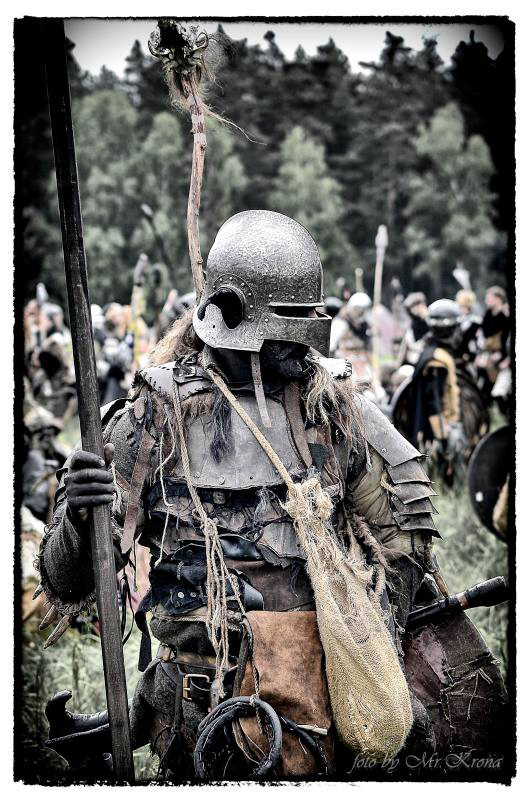
Photograph made by: Mr. Krona
Or perhaps this:
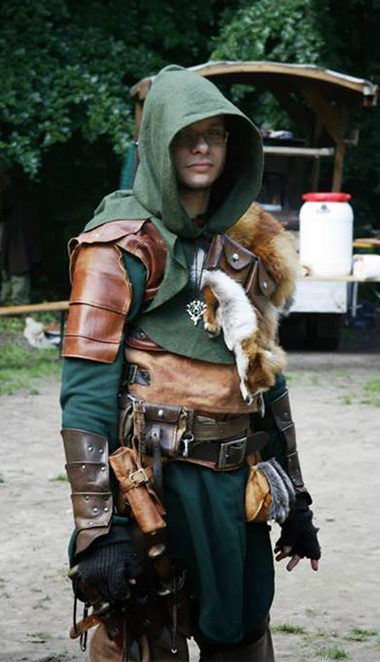
They’re complex, they’ve got many layers and when I started LARPing I thought I’d never own such costumes. But those who know me and have seen my costumes know that the last picture is actually one of my own costumes. This may seem like senseless self-promotion, but I’ve done this on purpose; I know how this costume came to be. For a quick visual overview, here’s how it looked in previous years:
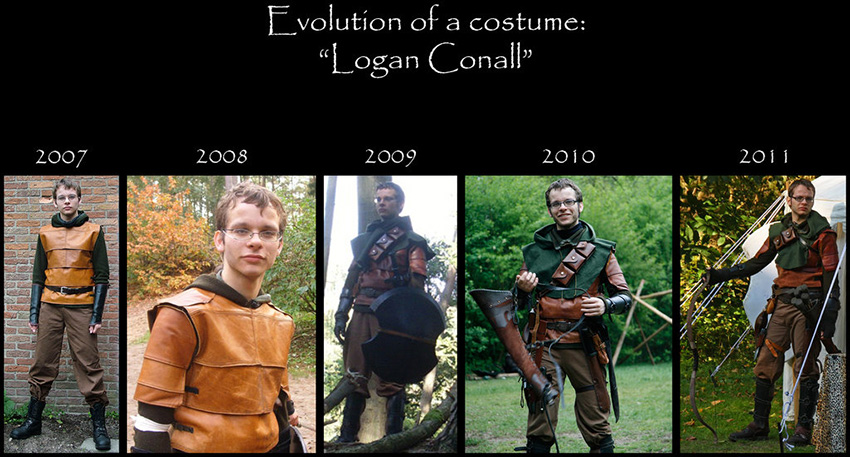
I hope you like the looks, because it’s the kind of costume I’ll try to help you create. Like LARP itself, there are multiple ways to do this – I’ll explain you mine and hope that you can get some useful information out of it!
Every costume I create starts with a concept: a few words or a sentence to describe what I’m going for. The ranger costume above started with, as you may have guessed: “ranger”. I’ve also got “Undead knight”, “John Constantine with more military training” and “scavenger”, to name but a few. This probably doesn’t differ much from how you start the character itself, which is good: a costume is an integral part of your character, your LARP persona.
For example: everyone you meet has clothing that fits him or her. More so, it fits his or her job. Two car mechanics will probably both have practical clothing, but they’ll still differ. One may have a generic coverall, while the other might have one that clearly has a company logo on it.
Two knights are probably both fitted with a full suit of plate armour, but it may very well be that one is shiny and the other not so, indicating that the latter may be more of a mercenary. Or perhaps even Undead.
The costume you wear communicates what kind of character you are playing. You can (and should!) be asking and answering questions about your character. For example: is he a professional? Self-taught? Patriotic? Rich or poor? Are there things that he absolutely loathes to wear and are there things he loves? Are there things he needs – things that are dictated by his profession and status?
Just like you, your character could have a fashion sense and taste – which may or may not differ from your own. Perhaps in the setting where he’ll be participating, there’s even an official dress code for his specific race or job.
A small note: while your costume communicates what kind of character you are, for some concepts (spy, assassin, thief, etc.) it makes sense to muddle and confuse that communication. I personally think it’s too easy to keep secrets at a LARP and I think that having secrets leak out is fun and promotes role-play. I won’t go too deeply into the subject, given that’s not what this blog post is about, but I recommend you to keep it in mind if your concept calls for it.
With the concept in hand and some questions answered, I tend to move on and look for visual references. This is where the concept comes into play as well, as searching for “ranger” on Google yields more usable results than searching for “fantasy costume”. Movies, videogame concept art and your fellow LARPers are most likely to yield useful pictures. What you should look for are not whole costumes to copy, but ideas. Cool little things that make a costume stand out. This can be anything like a specific colour scheme, the shape of a helmet, the kind of weapon, anything. If you aim to join an already existing group, the things you’re looking for are what clearly mark a character as part of this group. I can’t sketch at all, so all the pictures I like I just save to my computer, but if you can sketch, this is probably the best time to sketch out what you want your costume to look like.
By now you’ll (hopefully) have a solid idea of what you want your costume to look like. You might not be able to put a finger on why (exactly) you like the references you chose, but you have them. I hope you enjoyed the read! Alexjuh will take it from here again.
Special mention for this entry: Doomsday General. Thank you for your input on this topic and for helping me with translation, grammar and filtering out little mistakes.
Next entry: Costume, Layers
Dit artikel is oorspronkelijk gepost op Alexandra’s blog (24 maart 2014) en is opnieuw beschikbaar gesteld voor LARP Platform.
Alexandra is momenteel actief met het organiseren van Dark Union, een unieke bad guy LARP in Nederland. Daarnaast is ze heel creatief meer leerbewerken onder handelsnaam Layers.
Aanmelden nieuwsbrief
Contact
Wil je samenwerken met LARP Platform, heb je vragen of opmerkingen? Neem dan contact met ons op.
LARP Platform is onderdeel van Stichting Verhaal in Uitvoering.